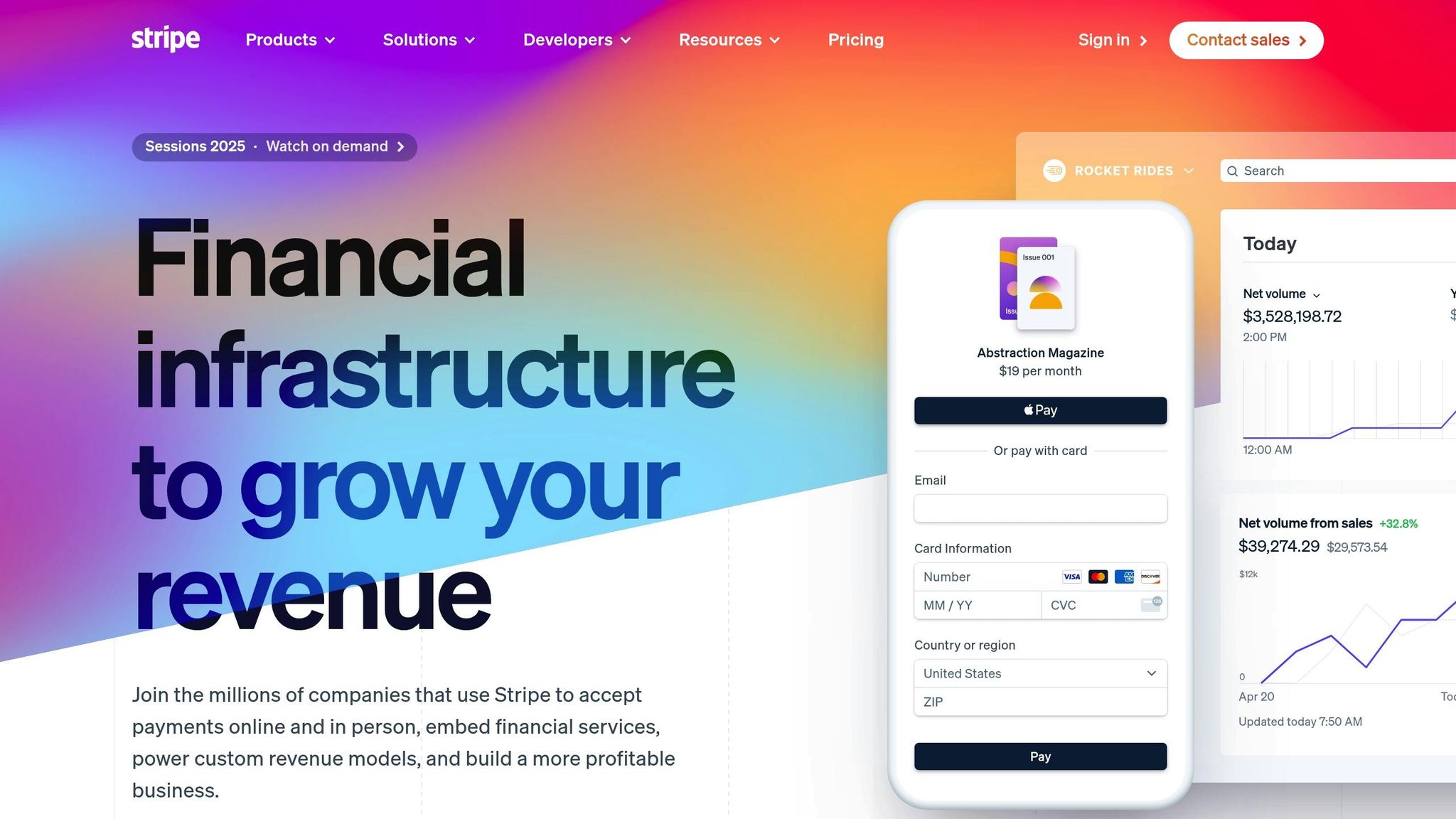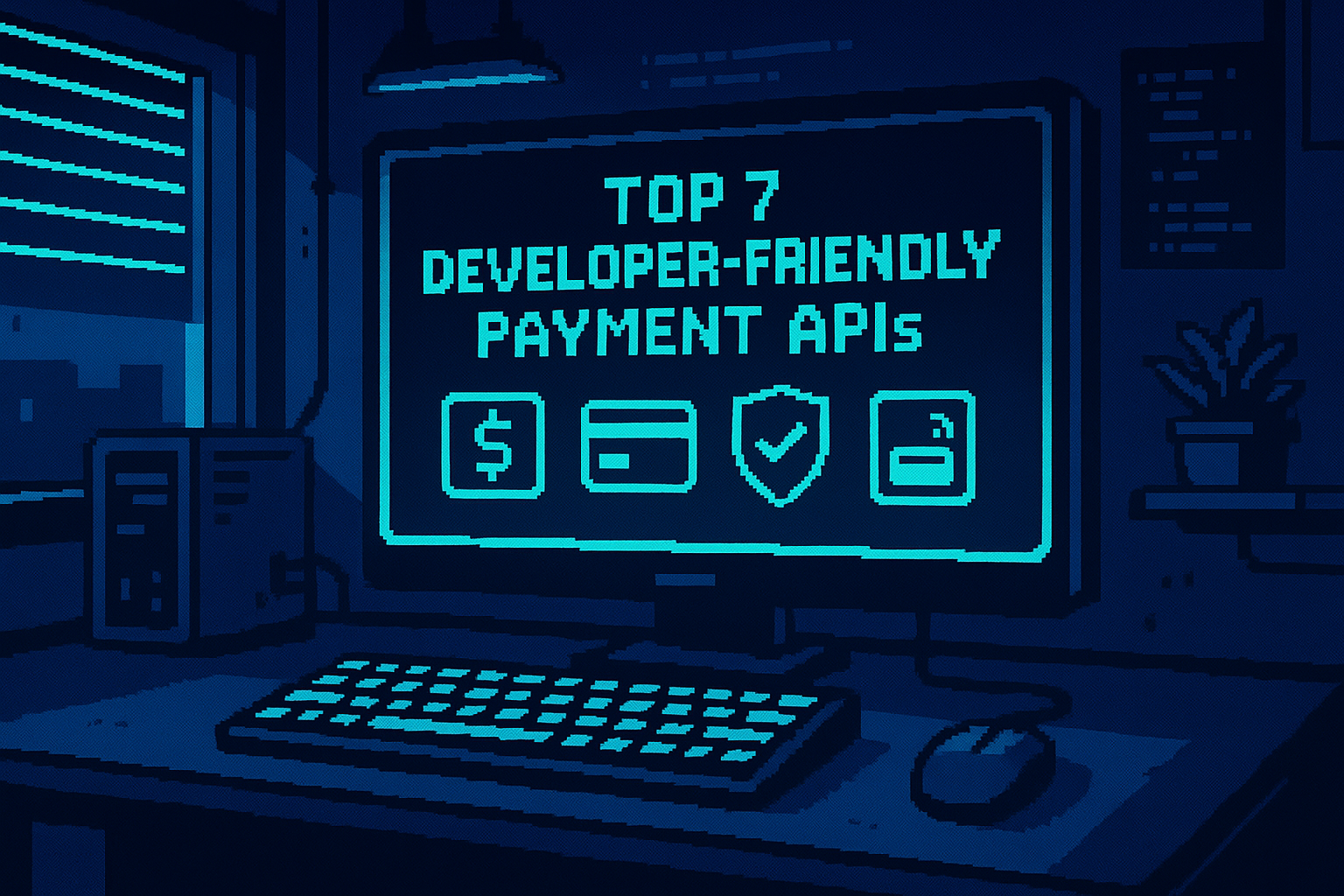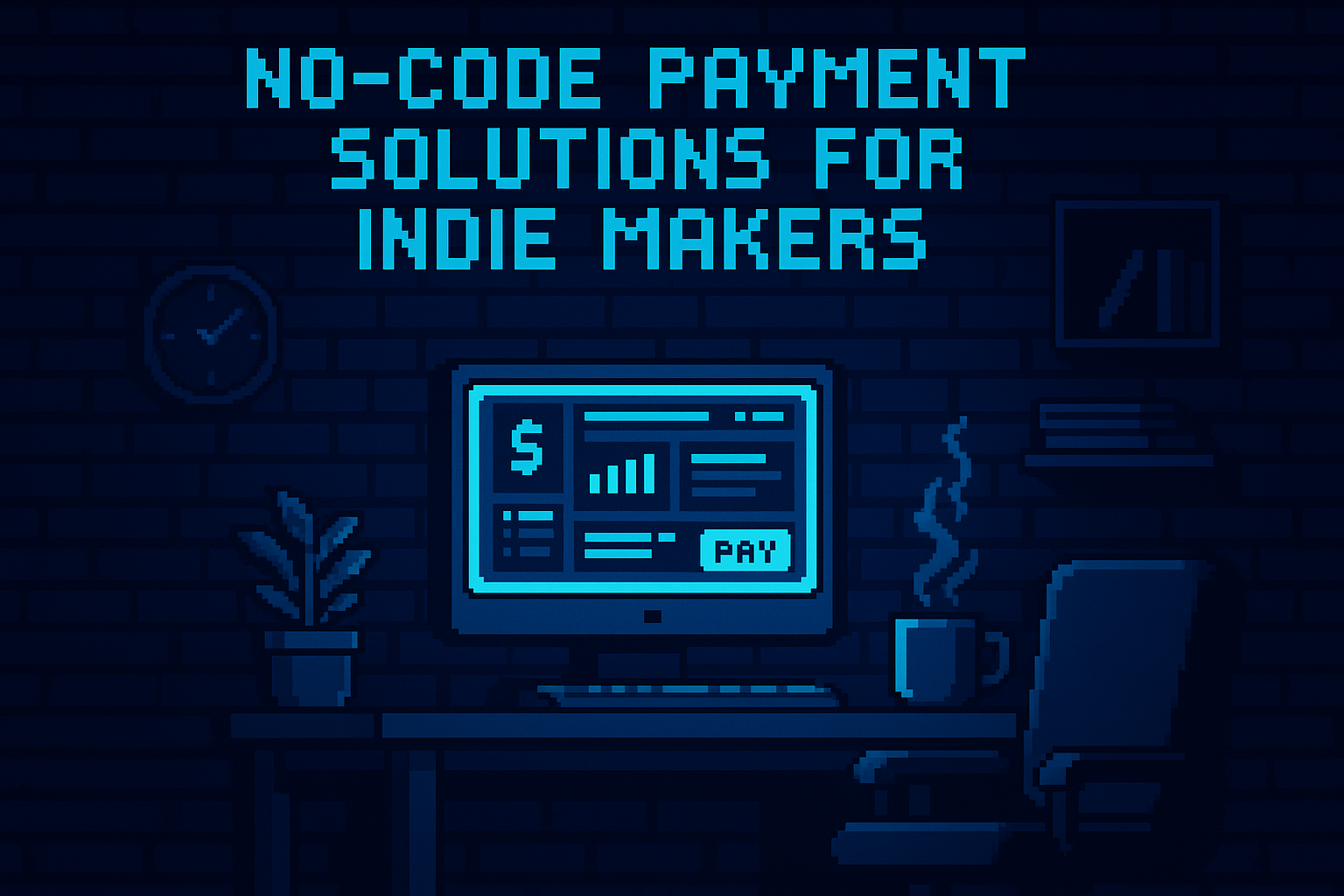Stripe and PayPal are two of the most popular payment processors for SaaS businesses. Which one is better? It depends on your priorities.
- Stripe: Best for businesses needing flexible subscription management, advanced APIs, and lower international fees. Ideal for companies with technical resources and global ambitions.
- PayPal: Known for its global trust and ease of use. Great for businesses prioritizing simplicity, quick setup, and brand recognition.
Quick Comparison
| Feature | Stripe | PayPal |
|---|---|---|
| Transaction Fee | 2.9% + $0.30 | 2.9% + $0.49 |
| International Fee | +1% | +1.5% |
| Currency Conversion | +1% | Up to 4% |
| Recurring Billing | Included (0.5%-0.8%) | $10-$30/month |
| Customization | Advanced APIs | Limited customization |
| Ease of Setup | Requires technical skills | Simple, user-friendly |
| Fraud Protection | Machine learning (Stripe Radar) | Standard tools available |
Stripe is better for businesses with complex billing needs and international customers, while PayPal is ideal for those seeking simplicity and leveraging its trusted brand.
Stripe vs Paypal: Which is Better? An In-Depth Comparison 2022

Stripe Overview
Stripe is a developer-friendly platform designed to handle everything from simple transactions to intricate recurring subscriptions, including usage-based billing. For SaaS businesses, it offers a robust billing infrastructure capable of managing one-time payments and complex subscription models.
Key Features
Stripe Billing is tailored for subscription-based SaaS businesses, providing tools to manage recurring billing and subscription workflows. It supports various pricing models such as flat-rate, tiered, per-user, and usage-based pricing.
One standout feature is Smart Retries, which leverages machine learning to recover failed payments at the most effective times. This can help businesses recover 11% more revenue compared to retrying payments on a fixed schedule.
| Feature | Description |
|---|---|
| Recurring Billing | Automates recurring charges on a daily, weekly, monthly, or annual basis |
| Usage-Based Billing | Calculates charges based on actual product usage |
| Tiered Pricing | Applies different rates depending on volume tiers |
| Customer Portal | Enables customers to manage subscriptions, payment methods, and invoices |
| Smart Retries | Uses machine learning to retry failed payments at optimal times |
| Revenue Recognition | Automates complex accounting and reporting tasks |
Stripe supports over 135 currencies and a wide range of local payment methods. It also integrates seamlessly with essential business tools like Salesforce, NetSuite, and Xero, simplifying operations for growing SaaS companies.
The platform has delivered measurable results for businesses. For instance, Postmates gained over $63 million in revenue by reducing involuntary churn. Using Stripe's card account updater, they automatically updated two million expired customer cards, generating $60 million in additional revenue. Meanwhile, Smart Retries recovered more than 200,000 failed payments, adding $3 million to their bottom line.
Typeform also revamped its billing system with Stripe, allowing them to launch new subscription plans billed monthly or annually. This transition automated customer upgrades, streamlined recurring invoicing, enabled multi-currency payments, and simplified financial reporting - all without manual intervention.
These features highlight Stripe's capability to handle the complex billing needs of SaaS businesses, setting the stage for a closer look at its pricing model.
Pricing Structure
Stripe follows a pay-as-you-go model with no setup or monthly fees for basic payment processing. Standard fees are 2.9% + $0.30 per online card transaction.
Additional charges include:
- ACH transfers: 0.8% per transaction, capped at $5.00
- International card fee: 1.5% added to the transaction amount
- Currency conversion: 1% of the transaction amount
- Dispute/chargeback fee: $15.00 per occurrence
For subscription management, Stripe Billing offers two pricing tiers: the "Starter" plan at 0.5% of recurring charges and the "Scale" plan at 0.8% of recurring charges. High-volume businesses can negotiate custom pricing with potentially lower rates.
Stripe-hosted invoices are often paid three times faster than traditional invoices, which can significantly improve cash flow for businesses managing recurring billing cycles.
US-Specific Features
Stripe offers tailored solutions for US-based SaaS companies, such as ACH transfers for direct bank payments - ideal for large B2B subscriptions.
The platform is PCI DSS Level 1 compliant and includes fraud detection through Stripe Radar, which uses machine learning to identify and block fraudulent transactions. This reduces the burden of managing security and compliance for businesses.
For developers, the Developer Dashboard provides real-time API monitoring, error filtering, and webhook event tracking. These tools give development teams in the US clear visibility into their operations. Additionally, Stripe's extensive documentation and libraries in multiple programming languages make integration straightforward, even for smaller teams.
With its advanced security, seamless integrations, and developer-focused tools, Stripe proves to be an excellent fit for SaaS companies operating in the US.
PayPal Overview
PayPal boasts a global presence, serving over 400 million active customers worldwide. Known for its strong reputation and flexible payment options, it provides SaaS businesses with an all-in-one solution that includes multichannel processing, fraud and risk management, and payouts, all integrated into a single platform.
One of PayPal's standout advantages for SaaS companies is its extensive customer base and user-friendly interface. With over 30 million merchants already relying on PayPal, the platform offers immediate credibility and trust, which can help drive higher conversion rates. It supports transactions in more than 100 currencies and ensures secure online transactions through buyer and seller protection.
PayPal simplifies payments for SaaS businesses by offering features like cryptocurrency acceptance, where customers can pay in crypto while businesses receive cash. It also integrates recurring payments directly into the PayPal Checkout platform, reducing friction in the payment process and enhancing the customer experience.
Let’s take a closer look at the features that make PayPal a go-to choice for SaaS businesses.
Key Features
PayPal caters to both straightforward subscriptions and more complex usage-based billing models. Its payment processing tools are designed to streamline checkouts and improve conversion rates.
For recurring billing, PayPal provides built-in subscription management, allowing businesses to set up fixed or quantity-based pricing models and even offer discounted or free trial periods.
| Feature | Description |
|---|---|
| Recurring Billing | Integrated with PayPal Checkout for automated scheduling |
| Multi-Currency Support | Handles transactions in over 100 currencies |
| Payment Methods | Accepts PayPal accounts, credit/debit cards, and Venmo |
| Custom Invoicing | Tools to create, send, and track invoices |
| Cryptocurrency Support | Customers can pay with crypto while businesses receive cash |
| Subscription Management | Centralized dashboard for managing subscription details |
PayPal's Payflow solutions offer two distinct integration options. Payflow Link provides a hosted checkout experience, while Payflow Pro allows for fully customizable checkouts. Both options include fraud protection and have been shown to boost online checkout conversion rates by up to 44%.
PayPal has delivered measurable results for major brands. For instance, HelloFresh reported a 3% increase in approval rates after optimizing its payment processes with PayPal.
"PayPal strives to revolutionize the digital commerce space. PayPal is giving us the tools and support to further grow our business."
- Emina Zahirovic, Associate Director of Global Payments, HelloFresh
Pricing Structure
PayPal operates on a pay-per-transaction model, with no monthly fees for basic business accounts.
US Transaction Fees:
- Online payments: 2.9% + $0.30 per transaction
- Higher-risk transactions: Up to 3.49% + $0.49 per transaction
- Micropayments: 4.99% + $0.09 per transaction
Additional Fees:
- International transactions: Extra 1.50% fee
- Currency conversion: Up to 3% above the base exchange rate
- Invoicing subscription: $14.99 per month
- Bill Pay syncing: $9.99 per month
For gateway services, Payflow Link is free with a $0.10 per transaction fee, while Payflow Pro costs $25 per month plus $0.10 per transaction. Add-ons include Recurring Billing ($10/month), Advanced Fraud Protection ($10/month + $0.05 per transaction), and Buyer Authentication ($10/month + $0.10 per transaction).
High-volume merchants can request volume discounts, which can make PayPal a more affordable option for large-scale SaaS operations. Additionally, PayPal simplifies accounting by automatically deducting fees from payments.
US-Specific Features
PayPal offers several features tailored to US-based SaaS businesses. It supports popular payment methods like Venmo, which is particularly effective for reaching younger audiences. This allows SaaS companies to leverage Venmo's user base while maintaining their existing PayPal infrastructure.
The platform ensures PCI compliance and includes advanced fraud protection. Its Advanced Fraud Protection Service uses machine learning to flag suspicious transactions and is available for $10 per month plus $0.05 per transaction.
For B2B SaaS companies, PayPal’s custom invoicing tools provide a professional way to create invoices, track payments, and manage billing history. These tools align well with US accounting standards and offer detailed transaction reporting for tax purposes.
A notable example of PayPal’s impact is its partnership with Walmart Marketplace. By using PayPal’s Hyperwallet product, Walmart saw a 629% increase in payout volume and a 130% growth in the number of sellers using the service.
"Walmart Marketplace was able to accelerate its growth by seamlessly onboarding sellers who choose Hyperwallet. Plus, convenience and transparency help make Hyperwallet an appealing choice for sellers."
- Konstantin Zuzik, Senior Manager of Payment Policy, Walmart
PayPal’s widespread acceptance and familiar interface make it an appealing choice for SaaS businesses that prioritize ease of use and customer trust over highly specialized billing features. Its proven track record across industries further cements its role as a reliable payment solution.
sbb-itb-a989baf
Stripe vs PayPal: Side-by-Side Comparison
With the core features of both platforms laid out, it's time to compare them directly. Below is a table that highlights the key differences impacting SaaS businesses.
Comparison Table
Here’s a quick look at the features and costs that matter most for SaaS operations:
| Feature | Stripe | PayPal |
|---|---|---|
| Transaction Fees | 2.9% + $0.30 per charge | 2.9% + $0.49 per transaction |
| International Cards | +1% fee | +1.50% fee |
| Currency Conversion | +1% fee | Up to 4% fee |
| Chargeback Fee | $15 per dispute | $20 per dispute |
| Recurring Billing | Included at no extra charge | $10–$30 monthly fees |
| Micropayments | Same flat rate (2.9% + $0.30) | 5% + $0.05 per transaction |
| API Customization | Extensive developer tools and APIs | Basic customization options |
| Setup Complexity | Requires technical knowledge | Simple, user-friendly setup |
| Customer Support | 24/7 availability (with longer wait times) | Shorter wait times (no 24/7 support) |
| Market Share | 17.2% globally | 45.4% globally |
| Payment Volume (2024) | $1.4 trillion (+38% YoY) | $1.68 trillion (+10% YoY) |
While the table provides a snapshot, the following sections dive deeper into the pros and cons of each platform.
Pros and Cons
Stripe is often the go-to choice for businesses handling smaller or international transactions due to its lower costs.
Stripe Advantages:
- Lower fees for small-scale and international transactions
- Highly customizable APIs for a tailored checkout experience
- Built-in tools for managing subscriptions and recurring payments
- Developer-friendly design that supports advanced technical needs
Stripe Disadvantages:
- Requires technical expertise for setup and maintenance
- Transaction fees are not refunded for returned payments
- Support wait times can be longer due to 24/7 availability
PayPal, on the other hand, shines with its simplicity and global reputation.
PayPal Advantages:
- Trusted by consumers worldwide, which boosts checkout confidence
- Easy setup with minimal technical know-how required
- Faster customer support responses during business hours
- Partial fee refunds on returned payments
PayPal Disadvantages:
- Higher fees for micropayments and international transactions
- Limited API customization compared to Stripe
- Monthly fees for advanced features like recurring billing and fraud protection
- Complex pricing structure with unpredictable add-on costs
The choice between Stripe and PayPal often depends on your SaaS business’s technical resources and priorities. Payment expert Bryce Emley from Zapier sums it up well:
"Choose Stripe if: You prioritize lower fees, simple pricing structures, and customizable, AI-optimized checkout experiences."
"Choose PayPal if: You care more about brand recognition and customer trust than cost savings, or need the easiest possible setup with minimal technical requirements."
Both platforms enjoy high user satisfaction ratings of 4.6/5 stars, but for different reasons. Stripe users value its reliability and flexibility, while PayPal users appreciate its global acceptance and familiar interface. However, Stripe users often point out challenges with its dispute resolution process, and PayPal users sometimes express frustration with slower issue resolution and limited phone support.
For high-volume SaaS companies, Stripe’s rapid growth makes it a strong contender, while PayPal’s broad market presence reinforces its position as a trusted payment solution.
How to Choose the Right Payment Processor
Now that we've covered the detailed feature comparisons, let's dive into practical scenarios to help you decide which payment processor aligns with your business needs. Your choice should reflect your technical capabilities and operational goals.
When to Choose Stripe
Stripe is a great fit for businesses that need a highly tailored checkout experience and have the technical resources to handle complex integrations. Supporting over 135 currencies, Stripe offers a robust billing suite that includes features like multiple pricing tiers, customizable trials, and coupon options - all without additional setup fees.
One standout feature is Stripe's data portability, allowing businesses to securely transfer customer payment data if they switch processors, minimizing vendor lock-in. Stripe also offers attractive international transaction fees, with lower charges for processing foreign cards and currency conversions. This makes it a cost-effective option for businesses handling global payments.
When to Choose PayPal
PayPal works well for SaaS businesses that prioritize simplicity and customer trust over technical customization. It's particularly appealing for non-technical teams focused on developing their products rather than managing payment infrastructure.
With over 360 million active users worldwide, PayPal's well-known brand can help boost customer confidence and improve checkout conversion rates. If you're already using PayPal for invoicing or payments, extending its use can streamline your financial processes. Additionally, PayPal can be advantageous for handling micropayments, though this is less common in standard SaaS pricing models.
These factors provide a solid foundation for exploring specific considerations for US-based businesses.
US Business Considerations
For SaaS companies in the US, factors like sales tax compliance and market dynamics play a vital role. Stripe Tax offers automated tax calculations (though businesses remain responsible for accuracy), while PayPal does not provide direct sales tax support.
PayPal's global reach and brand recognition - holding 50% of the market compared to Stripe's 15% - can be a key advantage for newer businesses looking to build trust with customers. However, there are slight differences in chargeback fees between the two platforms.
Stripe's API ecosystem is another major advantage, seamlessly integrating with popular US business tools like accounting software, CRMs, and analytics platforms. Both Stripe and PayPal meet PCI compliance standards, but their fraud prevention methods differ. Stripe uses tokenization and its Stripe Radar system, while PayPal employs multi-factor authentication and advanced fraud detection systems.
Ultimately, the right choice depends on your technical needs and operational priorities. SaaS companies with strong development teams and plans for international expansion may find Stripe's flexibility and cost structure more appealing. On the other hand, businesses looking for quick setup and leveraging brand recognition might lean toward PayPal.
Conclusion
Deciding between Stripe and PayPal for your SaaS business hinges on your technical capabilities, growth plans, and customer needs. Both platforms handled over $1.4 trillion in payment volume during 2024, proving their reliability at scale.
Stripe stands out for SaaS businesses that prioritize flexibility, scalability, and cost-conscious growth. With a transaction fee of 2.9% + $0.30 and the ability to accept payments in over 135 currencies, it offers more favorable economics for businesses aiming to expand. Its developer-friendly tools make it ideal for managing complex subscription models and facilitating international growth.
"Stripe is renowned for its developer-centric approach, providing extensive API customization. It's particularly favored by businesses that require tailored payment solutions and seamless integration with their existing systems."
- Zactra Technologies Inc
On the other hand, PayPal shines as a dependable choice for SaaS companies seeking simplicity and customer trust. With 45.4% of the global market share compared to Stripe's 17.2%, PayPal's brand recognition can enhance conversion rates. However, its higher transaction fees (2.9% + $0.49) and limited customization options may not suit businesses focused on scaling.
Your decision should align with your business's growth trajectory. If you're targeting rapid expansion, global reach, or intricate billing needs, Stripe's advanced tools and competitive pricing are likely a better fit. For businesses requiring a straightforward setup and leveraging customer familiarity, PayPal offers a reliable solution.
Keep in mind, switching payment processors later can introduce technical challenges and impact customer experience. Choose the platform that supports not just where your SaaS business is today, but where it’s headed tomorrow.
FAQs
What are the key differences between Stripe and PayPal for managing international payments in SaaS businesses?
Stripe supports payments in over 135 currencies and keeps international transaction fees relatively low, typically charging around 1% for currency conversion. This makes it a more budget-friendly option for SaaS businesses catering to a global audience.
On the other hand, PayPal operates in more than 200 countries but tends to have higher costs for cross-border transactions. Currency conversion fees with PayPal often fall between 3.5% and 4% per transaction, which can add up quickly for businesses handling frequent international payments.
For SaaS companies managing recurring billing across various countries, Stripe’s transparent and competitive pricing structure can offer a cost-effective and efficient way to handle payments worldwide.
What level of technical expertise is needed to set up Stripe versus PayPal, and how does this impact SaaS businesses?
Stripe leans heavily on its developer-friendly API and robust customization capabilities, which often require a higher level of technical expertise. This makes it an excellent option for SaaS companies with dedicated development teams or intricate needs. In contrast, PayPal shines with its ease of use, offering a simpler setup process that doesn’t demand advanced technical knowledge. This makes it a practical pick for smaller teams or those prioritizing quick and easy integration.
For SaaS businesses, the decision largely depends on their priorities. Stripe offers unmatched flexibility and room to grow, though it comes with a steeper learning curve. Meanwhile, PayPal focuses on speed and simplicity, albeit with fewer customization possibilities.
When should a SaaS business choose Stripe for customization over PayPal for simplicity and brand trust?
When a SaaS business needs flexible and tailored payment options, Stripe is a strong choice. It offers features like customized checkout flows, smooth integration with intricate systems, and advanced branding capabilities. This makes Stripe particularly appealing for companies with technical expertise or unique payment requirements that go beyond basic processing.
Meanwhile, PayPal shines when ease of use, quick setup, and brand recognition are top priorities. Its straightforward interface and worldwide reputation make it an excellent option for smaller teams or businesses seeking a reliable payment solution without the need for extensive development work.


